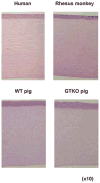Xenotransplantation--the future of corneal transplantation?
- PMID: 21099407
- PMCID: PMC3081421
- DOI: 10.1097/ICO.0b013e3181f237ef
Xenotransplantation--the future of corneal transplantation?
Abstract
Although corneal transplantation (Tx) is readily available in the United States and certain other regions of the developed world, the need for human donor corneas worldwide far exceeds supply. There is currently renewed interest in the possibility of using corneas from other species, especially pigs, for Tx into humans (xeno-Tx). The biomechanical properties of human and pig corneas are similar. Studies in animal models of corneal xeno-Tx have documented both humoral and cellular immune responses that play roles in xenograft rejection. The results obtained from the Tx of corneas from wild-type (ie, genetically unmodified) pigs into nonhuman primates have been surprisingly good and encouraging. Recent progress in the genetic manipulation of pigs has led to the prospect that the remaining immunological barriers will be overcome. There is every reason for optimism that corneal xeno-Tx will become a clinical reality within the next few years.
Figures
References
-
- Niederkorn JY. The immune privilege of corneal allografts. Transplantation. 1999;67:1503–1508. - PubMed
-
- Coster DJ, Williams KA. The impact of corneal allograft rejection on the long-term outcome of corneal transplantation. Am J Ophthalmol. 2005;140:1112–1122. - PubMed
-
- Chong EM, Dana MR. Graft failure IV. Immunologic mechanisms of corneal transplant rejection. Int Ophthalmol. 2008;28:209–222. - PubMed
-
- Coster DJ, Williams KA. Donor cornea procurement: some special problems in Asia. Asia-Pacific J Ophthalmol. 1992;4:7–12.
-
- Michaeli-Cohen A, Lambert AC, Coloma F, et al. Two cases of a penetrating keratoplasty with tissue from a donor who had undergone LASIK surgery. Cornea. 2002;21:111–113. - PubMed
Publication types
MeSH terms
Grants and funding
LinkOut - more resources
Full Text Sources
Other Literature Sources


